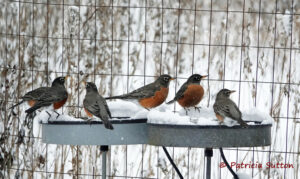 Our array of heated bird baths have been busy non-stop today (amidst the 8″ of snow we’ve had) with a variety of birds, including this flock of American Robins.
Our array of heated bird baths have been busy non-stop today (amidst the 8″ of snow we’ve had) with a variety of birds, including this flock of American Robins.
Heated bird baths are life savers during wicked winter weather. They provide crucial drinking and bathing water through snow storms and stretches when all natural water sources are frozen solid. This is especially important this winter since our area, South Jersey, is still in a state of extreme drought (that’s a step beyond severe drought shared on the U.S. Drought Monitor Map). Many of our normally wet woods remain bone dry.
Have you set up a heated bird bath this winter? If not, read on!
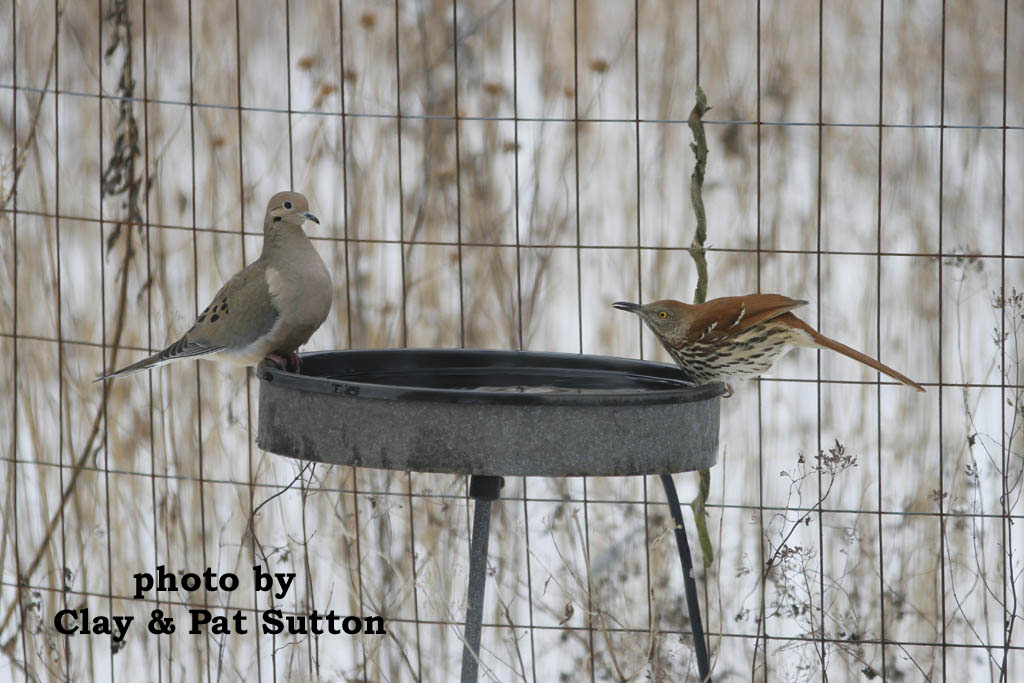
Wildlife needs are basic: food, cover, and water
FOOD needs can be met by planting (or preserving) native nectar plants and native berry-producing and seed-producing plants.
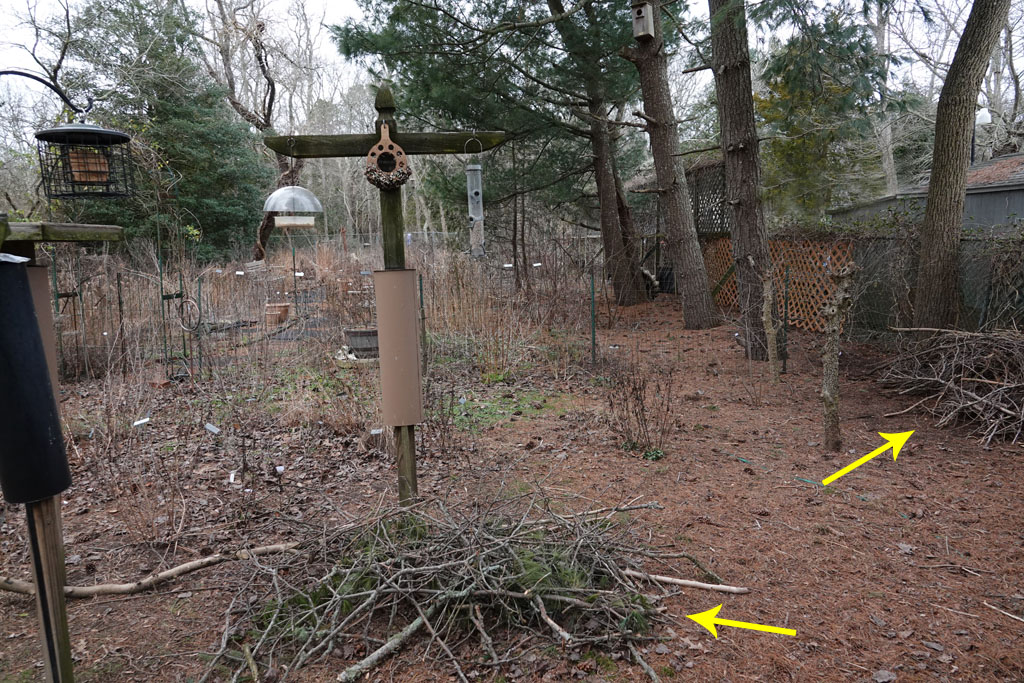
COVER is crucial so that birds and other wildlife can avoid becoming a predator’s next meal. Cover also provides safe places to nest, roost through the night, or get out of bad weather. Native evergreens like Red Cedar, American Holly, and Waxmyrtle offer excellent cover for wildlife. If your yard is wide open and without adequate cover, gather fallen branches and make a winter brush pile. You’ll be amazed by all the action it attracts as birds dash for the safety it offers when a hungry hawk flies through the yard. Or collect discarded Christmas trees and place them near bird feeding stations and bird baths, so that birds are not too vulnerable when they come to feed or drink or bathe. And next spring seriously consider planting a Red Cedar (or American Holly or Waxmyrtle) or two or three!
Providing WATER is just as important as providing food and cover
Songbirds lose water through respiration and in their droppings. To replace lost water, most songbirds need to drink at least twice a day. In order to stay fit and healthy birds also need to bathe to keep their feathers in good condition. Bathing loosens dirt and makes their feathers easier to preen. Preening is a daily ritual where birds carefully clean, rearrange, and oil their feathers (one-by-one) with their bill — spreading oil along each feather from the preen gland. This daily preening successfully waterproofs their feathers and traps an insulating layer of air underneath to keep them warm. Keeping their feathers in perfect condition through daily preening is a matter of life and death. Well maintained feathers enable birds to fly at a moment’s notice and regulate their body temperature.
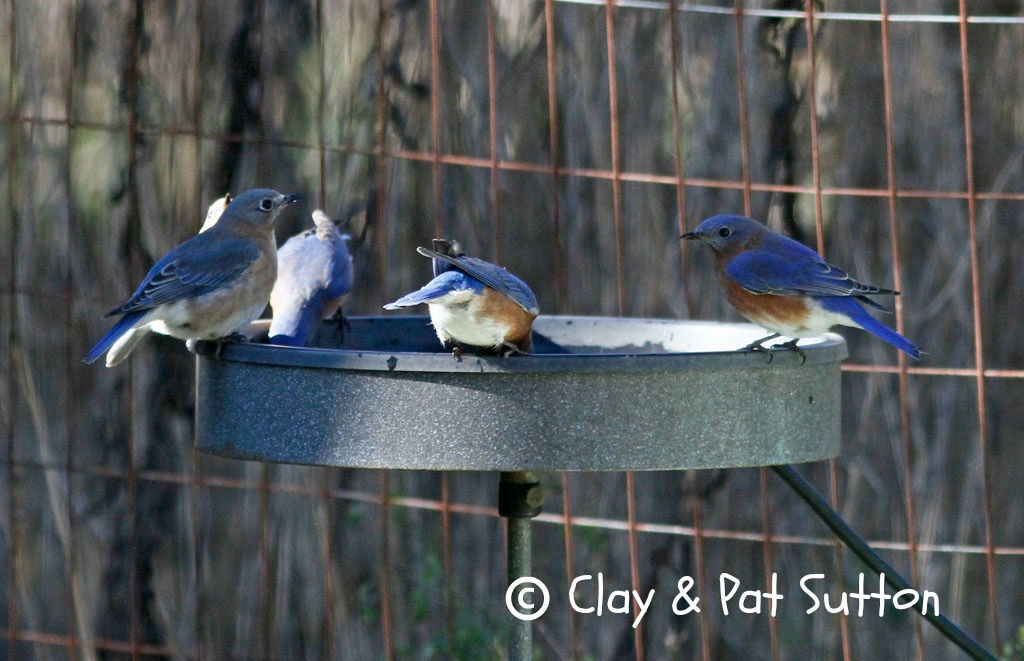
Birds face difficult times when water is scarce or nonexistent during deep freezes like have experienced several times already this winter and will undoubtedly face again this winter or during drought periods.
Heated Bird Bath
Providing water in the wildlife garden is something many accomplish easily spring through fall, yet fail to do once freezing winter temperatures settle in. There are solutions even in the dead of winter. A heated bird bath coupled with an outdoor socket is the key. We use an outdoor power cord to connect the two.
We’ve had our Pole Mounted ERVA Heated Birdbath (photo above) for over 25 years. The pole with its additional leg for support, when driven into the ground, makes this birdbath very sturdy so it remains standing no matter 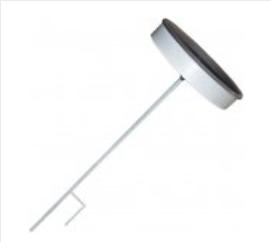 what! In the summer months I use the same stand to hold a large plastic dish/tray (like you’d put under a large flower pot) full of gooey fruit for butterflies. So even though expensive, this heated birdbath has served me (and wildlife) very, very well. Beware that most of today’s standing heated bird bath designs are tipsy by comparison (bird baths balanced on inadequate tripod legs), looking like they’d topple over every time a frisky squirrel leaps up.
what! In the summer months I use the same stand to hold a large plastic dish/tray (like you’d put under a large flower pot) full of gooey fruit for butterflies. So even though expensive, this heated birdbath has served me (and wildlife) very, very well. Beware that most of today’s standing heated bird bath designs are tipsy by comparison (bird baths balanced on inadequate tripod legs), looking like they’d topple over every time a frisky squirrel leaps up.
As of January 6, 2025, the Pole Mounted ERVA Heated Birdbath is available at 1st State Seed Garden Supply (best price, on sale at $30 less than other sites) and at Best Nest, Amazon, Freeport Wild Bird Supply, Feed the Birds, Walmart, and probably elsewhere (currently sold out at Nature House) .
Some heated bird baths rest on the ground and come with additional hardware so they can be attached to a railing like this one (photo above). If far from cover, place some cut evergreen branches nearby, as we have.
Wildlife gardening friend Jean Riling uses a Bird Bath De-icer unit to keep her bird bath water from freezing (photo below); Ed & Cindy Russell alerted me that the 80 watt de-icer handles the task far better than the 50 watt version. Ecosystem Gardener Carole Brown uses a heated dog bowl.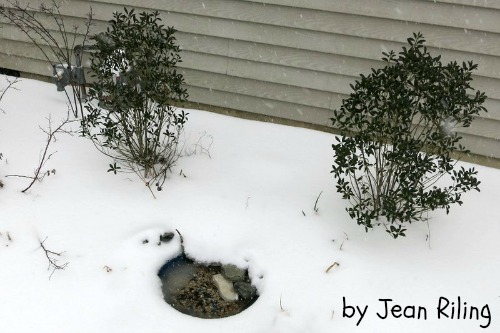
Garden Gang member Steve Mattan shared that he uses a special plug to control when his heated bird bath turns on and off (the plug / thermostatically controlled outlet powers ON at 32-Degrees and OFF at 50-Degrees ). How cool is that? Clay & I unplug our extension cord when it’s warm and plug it back in when temperatures drop, but this special plug can save the day if you’re not paying attention.
Shy away from “artistic” bird baths that may look pretty but are not as serviceable to birds: too deep, too fragile and likely to break if they topple over, or (most important of all) are too hard to keep clean. The heated bird baths we’ve used are made of a hard black plastic material that is very easy to clean with a good scrub brush and a little muscle.
If You Have a Wildlife Pond
If you have a wildlife pond and are thinking of putting a de-icer into it to make that your winter water source for birds, this could lead to some serious problems. If indeed large flocks of birds descend on your pond to drink, their droppings will accumulate in your pond and you could face an algae problem during the warm month fueled by all these bird droppings.
Remember, birds need cover to avoid hungry predators. Place your heated bird bath near a safe retreat like an evergreen tree or shrub or near a brush pile or, as we have, place some cut evergreen branches around it.
Stay away from chemicals!
Some folks, who don’t know better, add chemicals to keep their bird bath water from freezing (like glycerine, anti-freeze, or salt). This is a death sentence for the birds. These chemicals can destroy the waterproofing capability of birds’ feathers, or poison the birds.
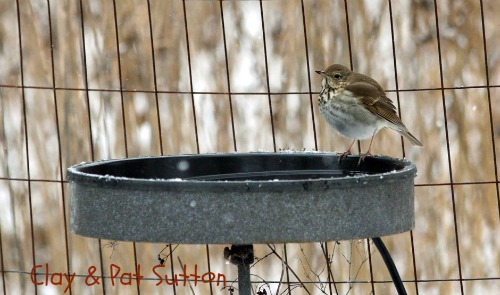
Scrub out, rinse, and refill daily
During lengthy periods of frozen conditions water is in such demand that heated bird baths become heavily soiled. To avoid the spread of disease, maintain your heated bird bath with care by scrubbing it out with a soft bristle brush, rinse it with fresh water to wash out any residual bird droppings, and refill it with fresh water at least once (and often twice) a day. With heavy use heated bird baths may be emptied by flocks of birds twice a day or more. We keep a jug of water handy by the backdoor to easily facilitate this task.
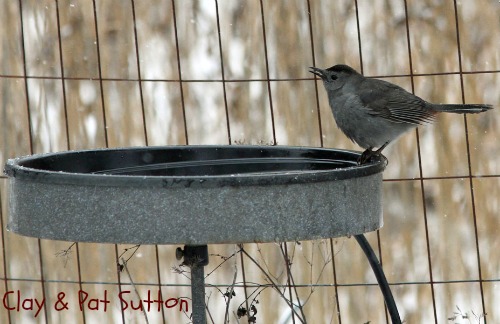
Beyond helping birds survive brutal winter weather, our heated bird baths give us great pleasure. We’ve had excellent looks (and photo opportunities) at some real skulkers like Hermit Thrush, Gray Catbird, Brown Thrasher, and other secretive birds not normally seen in our yard in winter.
Winter can be a stressful time for birds. Lengthy stretches of sub-zero weather can freeze solid every last bit of available water. Natural foods can be buried by snow. Heavy snow or freezing rain can creep into the deepest cover where birds are roosting.
If you have a tip to share, please do so in the comment section below. Shared comments and tips by fellow Garden Gang members have made this post stronger and stronger over the years. Thank you all!
Let’s do what we can to help birds survive a tough winter. Add a heated bird bath (or two or more) to your wildlife habitat this winter.
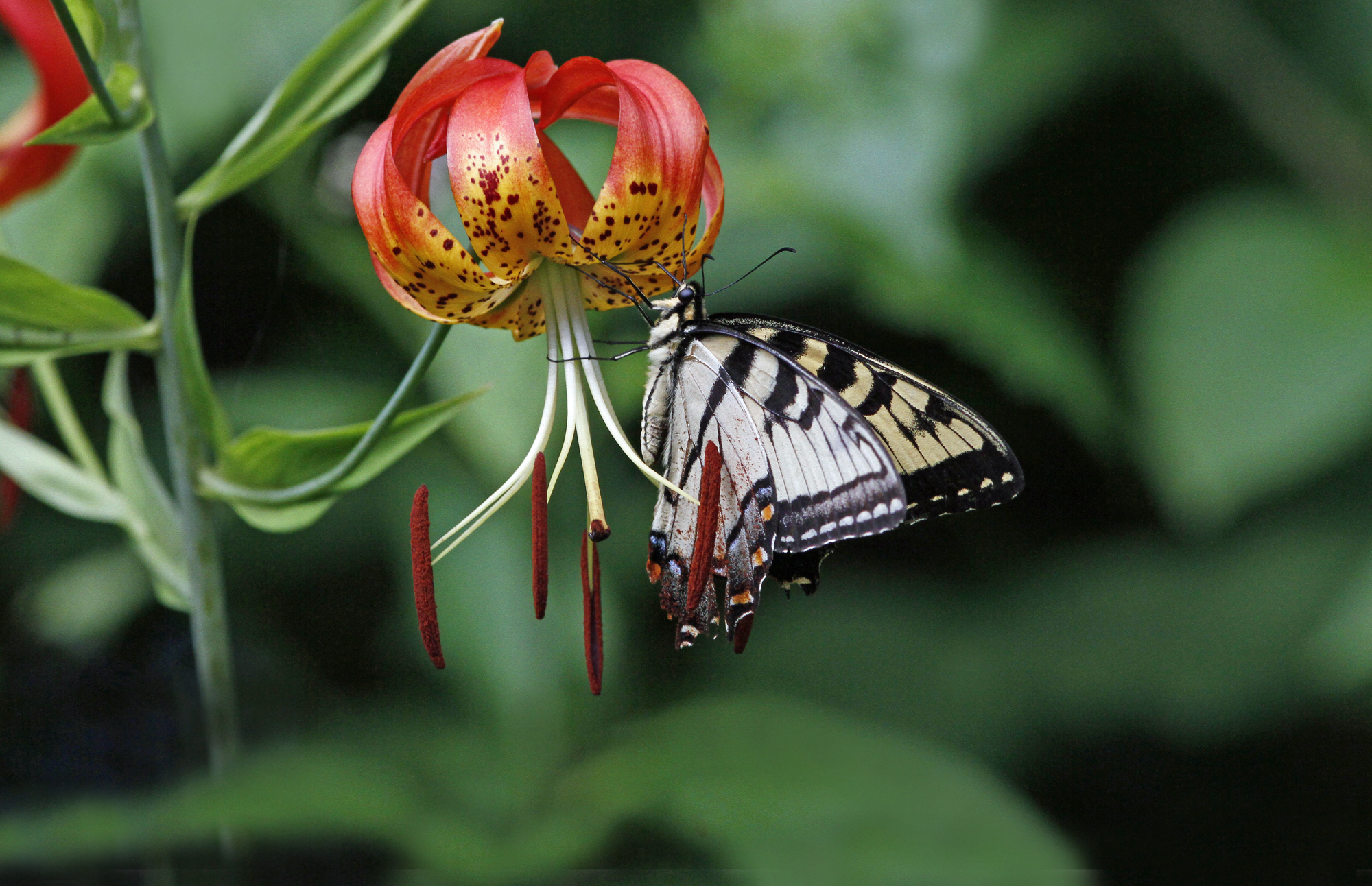
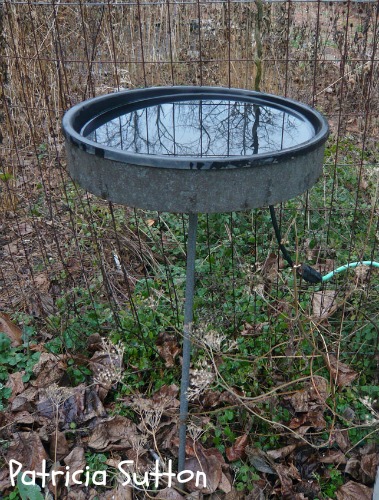
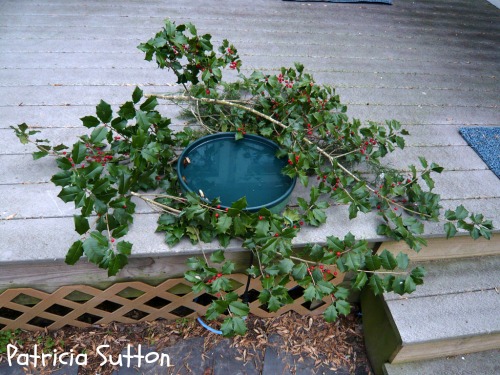
Hi, Pat– We’ve had success using an inexpensive birthbath de-icer from Wild Birds Unlimited for over 15 years, though it has had a tough time today. Ice accumulates on the edge of our concrete birth bath, so I boil a kettle full of water two or three times a day to help de-ice the edges. From looking at the water when I go out I know the birds are able to use it! Anne in Cherry Hill
I just ordered one Pat! All the others I’ve tried have just not worked under 20 degrees. Thanks for the tip!
Hi Pat: I only put tepid water in my winter bird baths since I was informed decades ago that if the water is too warm, birds will bath and then their wings will freeze. But your article starts out with the need for birds to bath regularly (implying all year long). I think that most heated bird baths only keep the water from freezing which supports what I was told. Will you please clarify about the water temp and winter bathing when under 32 degrees so that none of us with good intentions actually set-up a harmful situation for the birds. Thanks.
Hi Jim, yes, certainly do not put HOT water out for birds!!! In freezing temperatures, your best option is a heated bird bath (which keeps the water from freezing, but the water is by no means HOT to the touch). So if you do not have a heated bird bath, YES, add tepid water to your regular bird bath, but realize that it will quickly freeze.
Thanks Pat! I purchased a heated ERVA bird bath late last year based on your rave reviews. I haven’t used it as a heated bath yet, but we will set it up soon and plan to watch a great show this winter.
Are there any options for folks who don’t have outdoor electrical outlets?
Not really. It’s easy enough to hire an electrician to install an oudoor electrical outlet. We use ours for the heated bird baths in winter and our fountain and waterfall in the warm months. Not sure what we’d do without it. Also use it for outside tools.
Hi Pat,
How long is your outside electrical extension cord from bird bath to outlet?
Jan
Hi Jan, we have several outside extension cords. One to a waterfall (water feature) that we’ve tucked under an Alternate-leafed Dogwood and another to a fountain that is at the entrance to the arbor into our perennial garden. The sound of moving water is irresistible to birds. The longer of the two is about 50 feet. We use the longer of the two for our heated bird baths in winter. Pat
Pat, I had a “Blue Devil ” bird bath heater that fit in most any plastic birdbath for over 30 years. When it finally died, I tried a bunch of different immersion heaters but they would all die in a year or two. Finally found 2 new “Blue Devil” pail heater at a dog supply place and bent the copper tube 90⁰ near the heater to allow the clamp to connect to the edge of the birdbath rather than a deep bucket. Heater has a built-in thermostat in the Blue head that also shuts it off if the waterlevel gets too low. Senses water temperature and kicks on about 35⁰ and off about 50⁰. My birdbaths are about 21″ in diameter and 3″ deep so hold a good quantity of water, never freeze so long as the power stays on as low as its ever been in seaville , NJ. Did have the squirrels chew thru one of the extension cords causing the GFCI to trip when it would rain. Have had icicles hanging from the edge of the birdbath if the birds splash water over the side when the air temperature is well below freezing and the sun is not strong . Search for “Blue Devil ” on the internet
Hi John, “Blue Devil” pail heater sounds like a great solution! Thanks so much for sharing!!! Pat
Pat,
You advocate cleaning the birdbaths. I have several birdbaths and, in warmer months, noticed dragonflies and damselflies laying eggs in some of them. I understand emptying them to control mosquitos and other problems but still wonder. Some of my birdbaths get heavy use, requiring frequent refilling. Others mostly get used for drinking (might be location).
This winter I left the fallen leaves in the birdbaths and the birds and local wildlife don’t seem to mind. Can it be that the wildlife likes a bit of “flavor” in their water? I know honey bees will go for a dirty mudpuddle before a clean birdbath.
Hi Mil, I too enjoy providing habitat for dragonflies and damselflies for breeding. I have two fishless ponds with emergent vegetation that are perfect for them to lay their eggs in and create the next generation. Often they lay their eggs in plant material. When the dragonfly nymph hatches from the egg it finds lots to feast on in my pond. Dragonfly nymphs survive in my ponds because I do not have predators (fish) in the ponds. In the wild, dragonflies seek fishless ponds to lay their eggs in, if available. And when the nymph reaches adulthood, the emerging dragonflies (& damselflies) use the emergent vegetation to crawl out of the pond and spread their wings for the first time and dry them. They may remain on this emergent vegetation for hours spreading the wings and drying the wings before they can fly. A birdbath is pretty much a dead end for egg-laying dragonflies and damselflies. Some dragonflies take several years to reach adulthood, overwintering in the muck in the bottom of my ponds.
Hope this helps answer your questions. Thanks for asking! Pat
I recommend cleaning bird baths because when birds bath and drink, they often also poop. If bird droppings in the bird bath are from sick birds, disease can spread quickly through a population of birds. It’s just common sense to clean a bird bath to insure that drinking water is safe for drinking. Puddles in the wild after rains are short lived, but a bird bath may attract lots of birds and lead to lots of bird poop in the water.
Hi Pat, Thanks for all of your inspiring information!
I don’t have any water in my yard because I can’t commit to daily cleaning of a bird bath. I am looking for a low maintenance option for water that I can leave for a week or more at a time, year-round. Any ideas?
I also wonder, if I would be able to commit to cleaning daily for a week or so, but then (knowing that I am going away or going to be too busy) stop for a long time, am I doing more harm than good by doing just for a short time (again year-round)?
Debbie
Hi Debbie, I understand your dilemna! In winter I try to clean our heated bird baths at least once every three days. Sometimes, one or several of them are dry or almost dry from bird use (bathing and drinking) after one or two days. We certainly travel too and are away sometimes for a week or so. If this is the case in the winter, we unplug heated bird baths during our absence (for safety sake). If we are away for a week or so during the warm season, we tend to the bird baths as soon as we can, giving them a good scrub and rince, another scrub and rince, and then refill. We have two wildlife ponds that birds utilize for drinking in warm season months when the ponds are full of plants (water lily pads and Pickerelweed stems) that birds can land on and use as perch sites to take a drink. So a wildlife pond might be a solution. In the summer months you would not want to leave bird baths for over a week without scrubbing and washing out because they would be used by egg-laying mosquitoes. Asian Tiger Mosquitoes go from egg to emerging adult very quickly. I hope this helps!